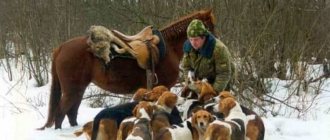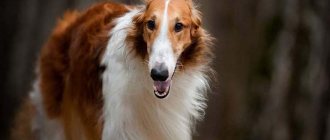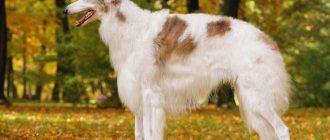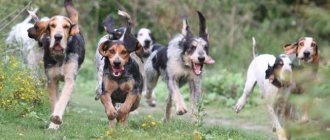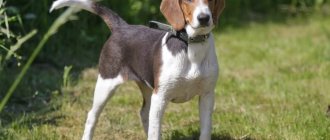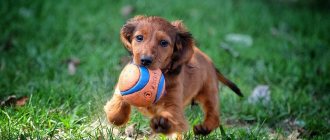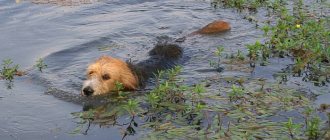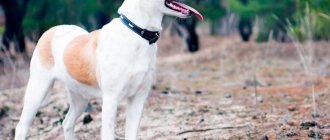Main characteristics
| Breed parameters | |
| Country of origin: | Russia |
| Weight of the breed: | males: 25-35 kg, females: 25-35 kg |
| Height at withers: | males: 58-68 cm, females: 58-64 cm |
| Temperament: | calm |
| Wool: | average |
| Role in human life: | hunting |
The Piebald Hound is not a companion dog and is not recommended for apartment living. The dog needs freedom and constant physical activity. If you are not a hunter, then this breed is not for you.
Origin story
At the beginning of the 19th century, every second person in Russia was breeding hounds, which led to confusion in the type and main characteristics. Every landowner who owned a kennel considered himself a great breeder.
Towards the middle of the 19th century, hounds lost almost all their anger towards wild animals and became completely unsuitable for hunting larger predators, for example, wolves.
Foxhounds helped correct the situation. At that time, they were considered ideal hunters and had a fixed phenotype, that is, they conveyed hunting skills well, which hounds really lacked. As a result of such a tandem, elegant and very hardy animals appeared in Russia, which were distinguished by their great working capacity and aggression towards wild animals. From their Russian brothers they took a loud ringing bark and incredible speed.
At the beginning of the journey to create a universal hunting dog, there were many problems, but there were also successes. The problems were directly related to the fact that many breeders of that time worked with different infusions, which is precisely why the result was unstable. Closer to the 30s, certain leaders emerged who received more successful specimens in terms of exterior and temperament. The most successful were: S. M. Glebova, I. L. Kramarenko, P. A. Bereznikova.
At the beginning of the 20th century, mixed breeds of Russian hounds and fox terriers began to be purposefully bred. By this time, the new breed had already successfully declared itself and perfectly demonstrated its qualities at local and regional exhibitions. In addition, they were assigned their own name - Anglo-Russian hounds.
Unfortunately, after the collapse of the Russian Empire, the newly created breed was on the verge of complete extinction. The general phenotype was again lost and some working qualities were lost.
In 1925, the first standard was developed, which instantly increased the value and importance of the hunting breed. Before the start of the Second World War, the population was about six elite lines. Regarding the name change, this procedure was carried out in 1947. According to other sources, the name changed in 1951.
Story
These animals appeared as a result of crossing the Russian hound with English and French similar dogs.
In the 19th century, hounds were bred by anyone who wanted them. As a result of such experiments, the main characteristics of the breed were lost, and the dogs became practically incapable of hunting wolves.
In order to somehow change the situation, it was decided to use foxhounds for crossing. The result was a dog that took the best qualities from both parents. However, in some cases, not only English dogs, but also French ones were used for breeding. Therefore, the purity of the breed has not yet been discussed. Over time, a group of leaders emerged whose varieties of dogs were the best and were the elite. The breed gradually developed, and in 1925 the first standard appeared.
Note! Initially it was an Anglo-Russian hound, but in 1947 it was decided to change the name to the Russian piebald hound.
a brief description of
The Russian Piebald Hound is a very hard-working dog that loves what it does. It turns an ordinary hunting trip into an exciting and fun game. Along with high activity, these dogs are endowed with a balanced psyche and a relatively calm temperament.
Hounds are very sociable, they quickly find a common language with the owner and are happy to help him in his daily work and worries. These animals will always be nearby during your daily jog, will keep you company during a trip to nature, and will join the family picnic. However, despite the apparent devotion to the family, these dogs are primarily hunters; for them, work will always come first. Therefore, you can earn their trust only by being an avid hunter.
Character
The Russian Piebald Hound is a passionate, agile, agile breed of dog. A devoted friend and brave hunter with an inexhaustible supply of energy. A companion for energetic and physically active people who are fond of hunting. Due to their natural purpose, most representatives of the breed have an obstinate disposition. The hound expresses its dissatisfaction or, conversely, its best mood with a ringing and drawn-out bark.
The dog is easy to train. The owner is required to show his character in upbringing, because the animal clearly senses “who is in charge in the pack” and obeys only the strongest. A distinctive feature of the English-Russian hound is that it can independently track down the most cunning animal and notify its owner about this with its characteristic barking.
The standard of the Russian Pinto Hound requires malice towards the animal. Aggression towards people is not allowed, even while hunting. In general, dogs of the piebald hound breed are good-natured, affectionate pets. They are very playful and love to misbehave.
Breed standard
Despite the close relationship between the piebald breed and the Russian hound, they are not exact copies of each other. Sometimes in hunting it is quite difficult to distinguish one from the other; the only difference is the spots on the pinto and the characteristic blush. In addition, there are some differences in the shape of the ear, as well as in movements.
- At the withers, piebalds can reach 68 cm, females are slightly lower, their weight is on average 30 kg.
- head is dry, oblong, with an average width of the skull, and not particularly voluminous. The occipital protuberance and brow ridges are slightly marked. The transition from the nose to the forehead is clearly expressed, the stop is gentle. In profile, the muzzle has the shape of a rectangle.
- The jaw is strong, the teeth are massive, even, white, scissor bite. The bridge of the nose is smooth, the mirror of the nose is clearly defined, voluminous, and black. The eyes are small, oval-shaped, slightly slanted, the eyelid is dark in color. Brown iris (all variations).
- The ears are triangular in shape, slightly rounded at the tips, drooping, the tips are approximately at eye level. The neck is moderately muscular, slightly rounded.
- The body is strong, with a low, massive chest, which is lowered to the level of the elbows, the back is wide, the croup is convex, and the groin is concave. The limbs are dry, bony and at the same time muscular. The paws are oval-shaped or rounded, gathered into a fist.
- The tail is saber-shaped, thick at the base and tapering towards the end. Leather without dewlap or unnecessary folds.
- The coat is double, of medium length, shorter on the paws, head and ears, in other areas it is approximately 5 cm longer. The longest coat is on the back of the neck and the outer side of the thigh. The undercoat is thick and dense.
- Acceptable color : the most common is black-and-piebald in blush, also there are purple-piebald with small patches, and gray-piebald in blush.
Vices:
- Any other eye color that differs from that specified in the standard.
- Tail drooping, curled or curled to one side.
- Steep stop, hump on the nose or upturned nose (snub nose).
- The presence of folds and their large number.
- Ears curled into a tube, excess hair.
- Lack of undercoat.
- Wavy wool.
- Dense speckled color.
- Clubfoot.
What should a Russian piebald hound look like according to the standard?
The Russian piebald hound dog is above average in size, with a strong type of constitution. Sexual dimorphism is well expressed. The height of the hatchlings is 58-68 cm, and the height of the hatchlings is 55-65 cm.
The head is dry, voluminous, but not wide. The skull is oblong, the foot has a soft ledge. The profile of the muzzle approaches a rectangle. The nose is large and black. The lips fit tightly. The ears are hanging, thin, not long, triangular in shape with rounded tips, fit tightly to the head, set high, can be folded or folded. The eyes are medium in size, brown or dark brown, the eyelids are round or slightly oblique. Scissor bite, teeth white, large and strong.
The neck is round, set at an angle of 45 degrees to the axis of the body. The chest is deep, broad, with barrel-shaped ribs that reach down to the elbows and below. The stomach is slightly tucked. The back is straight, the loin is wide, short and convex. The croup is slightly sloping. The front legs are straight, lean, and parallel. The hindquarters are muscular, bony, and the angulations are well defined. Paws are round or oval in shape, with tightly knit toes. The claws are pointed towards the ground. The tail is saber-shaped, tapering to the tip, long to the hock joint or shorter by 2-3 cm, held raised to the top.
The skin is dense, elastic, and does not form folds. The muscles are well developed. The bones are strong and wide. The hair on the legs, head and ears is short, and on other parts of the body - 4-5 cm. The hair is longer on the withers and back of the thighs, but not so long as to form a fringe. The tail is covered with hair evenly along its entire length, which visually makes it thicker.
The characteristic color for the Anglo-Russian hound is black and piebald with blush.
The size of the spots is not limited, up to a saddle cloth that can cover the entire body. Tan (blush) covers the shoulders, butt and head. Small streaks (dark spots) are acceptable on the temples and limbs. The belly is always white. Gray-piebald color with blush and crimson-piebald with slight speckling are also allowed.
Character and temperament
Outside of the hunting process, piebalds are calm and even lazy creatures; they do not cause any special problems, however, they have some features that the owner will have to get used to. In their free time from running, they prefer to accumulate energy, which they splash out in full on the next hunting trip. Consequently, they are practically not active at home.
These animals are too independent and independent, so they will never do what they try to force on them. For example, instead of humiliating themselves and begging for food, as many other dogs do, they will choose to take it without permission. In addition, they will not be shy to do this right in front of their owner and the entire family as a whole.
Application
It is recommended to purchase a gonchak solely for the purpose of hunting. This dog is not suitable as a pet. The hunter's instincts are quite strong. The inability to use them will depress the dog and contribute to a change in character. A dog can run away from its owner during a walk.
During the hunt, the animal realizes its potential. This is his native element. The dog senses game well and is able to track it for a very long time without getting tired. Properly trained Russian piebald hounds will be able to drive the animal as close as possible to the hunter. After the shot, the dog will find and bring the prey.
Hounds are capable of chasing any animal, even such a large one as a wild boar or a wolf. But it’s best to track small animals: hares, foxes.
Racers never say “bitch” or “male”, “boy” or “girl”. There is a “vyzhlovka” and there is a “vyzhlovka”.
Education and training
Many dog experts say that Russian piebalds have fairly high intelligence and good memory. However, excellent mental abilities do not guarantee obedience and attentiveness. Quite often during training, innate independence takes over, and the makings of a leader do not allow one to “bend the knee.”
Due to excessive self-will, it is recommended to socialize the dog as early as possible and train it from a very early age. Ideally, as soon as the puppy crosses the threshold of a new home.
Innate stubbornness and attempts to assert oneself will have to be taken for granted, since these qualities are inherent in nature itself and it is almost impossible to eliminate them. During classes, try to always leave the last word for yourself, never follow the dog’s lead, otherwise he will think that he is the head of the family. At the same time, in the process of education there should be no violence, swearing or too loud shouting. It is best to use rewards in the form of treats and dog treats.
Education experts recommend starting training at approximately 4 months of age. The first thing the dog must learn is the commands “sit”, “near”, “lie down” and “come”. By 5 months, the pet should master the muzzle, and you can also begin to teach it to swim.
Character and training
Unlike many hunting dogs, the character of the Russian Pinto Hound is distinguished by restraint and balance. It is possible to talk about these qualities, against the backdrop of excellent working skills, keen sense of smell and anger towards the animal, only thanks to the efforts of the breed year after year. Since hunting is becoming a hobby and is no longer a guarantee of survival, hounds are increasingly becoming pets. However, keeping in a family does not necessitate the need for exercise and compensation for instinctive needs for hunting.
Raising a Russian Pinto Hound puppy, methods and methods, directly depend on the purpose of your ward. If you are preparing a pet to work in the fields, you need to start far from choosing a training method. In the family of hunting dogs, the heredity and working qualities of the dog’s ancestors are extremely important. Do you want to choose a Russian Pinto Hound puppy that will show good results in tests? Forget about show class and buying second hand. You shouldn't rely on exterior titles, but performance test certificates are extremely important. Moreover, you should be interested not only in the parents, but also in the producers of the three previous generations. Agree, only serious breeding farms can have such a deep information base, and only they can guarantee the quality of the working skills of the younger generation.
Note! You can also buy a pet class puppy as a pet, because appearance and an “ideal figure” are not so important if the dog is a member of the family.
Russian Piebald Hounds are active and playful, but you must exercise control, especially during puppyhood. Give your ward time to rest after a race or swimming in a pond. Pay attention to the stability of the gait; if the dog becomes quiet, it is tired and needs a break.
The breed is loyal to the owner and all family members. It is not worth getting a Russian Pinto Hound as a guardian of the territory, but in a critical situation, the ward will not hesitate to stand up for the owner. In relation to other animals, hounds are quite individual. Judging by the experience of successful owners, the breed gets along well with cats, but hamsters, rats, ferrets and birds can become the “object” of hunting.
Important! When walking your ward in the parks, do not limit him in the manifestation of his instincts. Let the four-legged sniff the air, stand up, run after a butterfly or sparrow. Remember, you must be confident in practicing calling or walking your four-legged dog on a leash.
Training a Russian Pinto Hound is considered a task of moderate difficulty, but for people with experience it will not be difficult. The breed is famous for its excellent memory and desire to please its owner. An important factor in training is proper motivation. For the Russian Pinto Hound, playing fetch or running through an obstacle course together is much more valuable than a treat.
Hunting with Russian piebald
The main purpose of the breed is productive hunting, which is exactly what they were bred for. The dog shows aggression towards wild animals, runs fast and gets excited while working. She is very efficient and hardy, hunting with her is a pleasure. It is worth noting that Russian piebalds turned out to be more vocal than their hunting relatives, while they are heavier in running, but with a wider search range. An additional bonus for the owner is the elegant color, which does not blend into the terrain and the animal is clearly visible in the forest, therefore, the dog cannot be confused with prey.
To achieve good results in hunting, hounds will have to be trained, you need to be prepared for this. That is, if you want to see your assistant as a provider, and not just a pursuer, then you will have to work productively.
The breed perceives other animals as potential prey, so you need to be very careful when walking, because even a large dog can be perceived as a target for destruction.
You need to start introducing your dog to hunting either in the spring or in the fall, when there is not yet a carpet of snow on the ground. The puppy is simply taken out into the forest and given the opportunity to get acquainted with the area and different smells. This kind of walk should be intense, but not exhausting. The puppy should enjoy spending time in the forest, and not be discouraged from such trips.
You should not let your teenager follow fresh tracks of animals, as he will eventually get used to easy tasks and will not pick up a late trail. In addition, you need to teach your pet to notify its owner about the found trail, and not silently follow it.
National treasure: Russian piebald hound
Photo by Vladimir Sdobnikov.
In the general biological and zootechnical understanding, a breed is “a relatively numerous, integral, stable, consolidated, artificially created by man in certain socio-economic and natural conditions group (population) of animals of the same species, having a common origin, similar external morphological, physiological and economic properties and characteristics, as well as the same type of reaction to changes in the environment, which are persistently transmitted to the offspring.”
The Russian Piebald Hound, or as it was called until 1947, the Anglo-Russian Hound, was developed in Russia by crossing the Russian Hound with the Foxhound.
Among Russian hunters, interest in the Foxhound, which appeared in Russia in the second half of the 19th century, was mainly caused by the fact that this breed was completely consolidated and had a description of typical characteristics - unlike the numerous breed groups of hounds in Russia.
Unfortunately, by the 80s of the 19th century, the Russian aboriginal hound was greatly mixed, the ancient type of Russian hound was lost, in different “family” hunts there were separate, different varieties of the Russian hound, often mixed with other breeds - harlequins, Polish hounds, etc. It was to these “family” breeds that the blood of the Foxhound was added.
The Foxhound was a well-built, powerful, beautiful and elegant dog. His valuable qualities for hunting were also of considerable importance: restlessness, politeness, anger towards the animal. The latter was especially attractive, since by that time Russian hounds had stopped taking wolves in some hunts.
The reason for the success of Foxhounds was also that they were polite by nature, i.e. They were easy to train, which cannot be said about the Russian hounds of those times.
Thus, in the second half of the 19th century, many now new “family” varieties of hounds appeared in different regions of Russia, some of them similar in type to the Foxhound, and others to the ancient Russian hounds, or Kostroma.
The most famous were the Bereznikovsky, Glebovsky, Smirnovsky hounds, and somewhat later the hounds from the Gatchina and Pershinsky hunts. Unfortunately, some publications devoted to these Anglo-Russian “family” hounds are silent about the role played by the aboriginal Russian hound.
Yes, she sometimes did not shine in appearance, was disobedient and difficult to train, and was often distinguished by her bestiality, but she carried within herself and steadfastly passed on to her inheritance a flair, a voice and anger towards the beast.
However, as L.P. notes Sabaneev, in some hunts, Russian hounds and seasoned wolves “took no worse than the Anglo-Russian bastards of various sizes.” It is worth recalling that good Foxhounds of famous origin and impeccable build were found only among English aristocrats, who had been leading the breed for several generations.
| Photo from the archive of Pavel Gusev. |
For the most part, marriages without any pedigrees ended up on the mainland. The most typical representatives of this “marriage” are the Foxhounds Burgham and Cromwell, from which S.M. led his famous Anglo-Russian pack. Glebov. However, from these discharge notes, according to the definition of S.M. Glebova, the “fools” were bred by skillful selection of pairs and intelligent travel to one of the best Anglo-Russian packs.
One cannot help but wonder what high working qualities were inherent in the Russian hound, if even when mixed with Burgham and Cromwell, who were completely hopeless in terms of hunting, she steadfastly passed on her basic hunting qualities to her offspring.
The same can be said about the Bereznikovsky and Kramarenkovsky hounds, who managed to retain their voices and flair, since the working blood of Russian aboriginal hounds was subsequently repeatedly added to the original Anglo-Russian hounds.
What kind of breeding material came to Russia from the shores of Foggy Albion can be seen from what N.P. said. Pakhomov: “Ruperti’s flock of Foxhounds, which was at the exhibition of the Moscow Hunting Society (in 1912), was an obvious marriage.
I personally saw this pack on a parfors hunt and I must say that almost all the dogs had bad voices. Most of them went into the rutting season in silence, several dogs worked at the rutting areas, and in general I was left with the most unfavorable impression of this pack.”
It must be assumed that foxhounds that were far from better than the above-mentioned foxhounds were used as initial breeding material - overseas hounds in the Smirnovsko-Bereznikovsky flock, when creating the Pershino piebald flock.
In addition, P.A. The Bereznikovs added the blood of harlequins to their Anglo-Russians, from whom they inherited the “harlequin” shirt. In 1873 P.A. Bereznyakov, having stopped hunting, led the flock to Emperor Alexander II on the Gatchina hunt. Here the blood of various Russians, Anglo-Russians, and subsequently Foxhounds imported from England was repeatedly added to these hounds.
Apparently, the British were embarrassed to concede a “tribal marriage” to the Russian Emperor Alexander II, and sold (or gave?) what they themselves valued. It is not for nothing that the dogs from this hunt subsequently ended up in many other packs and always became successful breeding material, improving their bone structure, power and field qualities.
| Photo from the archive of Pavel Gusev. |
The Pershinskaya piebald flock belonged to Grand Duke Nikolai Romanov and existed until the 80s of the 19th century. The beginning of this pack were harlequins, to which Anglo-Russian and then French hounds were later mixed.
As a result of strict selection, the flock acquired a unique piebald color. This color and the type of Anglo-French-Russian hounds turned out to be very unstable, and Pershino dogs were absorbed by the bulk of Russian and Anglo-Russian hounds.
Hound packs I.L. Kramarenko came from the Anglo-Russian hounds of the Kaluga hunter V.A. Tamkeev and were initially conducted in a closely related manner. However, in 1900 I.L. Kramarenko ordered three Foxhounds from England and added their blood to his hounds.
I.L. did not disdain. Kramarenko and Russian hounds and subsequently repeatedly added blood to Russian hounds known for their working qualities. And this could not but affect the excellent work of the dogs.
Hunters were especially attracted by their unusually strong, amazingly beautiful, figured, full-bodied voices, and in some cases, low, deep bass. And, of course, not inherited from Foxhounds!
In appearance, despite the infusion of Foxhound blood, the hounds of I.L. Kramarenko was dominated by the type of eastern hound (high front, set and size of the ear, oblique cut of the eyelid). And it’s not without reason that A.O. Emke wrote about this pack that “it is only English-Russian in color, but in the type of Russian hound.”
In addition, almost all hounds I.L. Kramarenko were in a strong spot. From all of the above, we can conclude that at the end of the 19th and beginning of the 20th centuries in Russia there were several well-known and lesser-known packs of Anglo-Russian hounds. These were different types of flocks and nothing more. There was no question of any breed; elegant and spectacular crossbreeds were not yet a breed.
Let's turn to the definition of BREED and see that the different types of English-Russian crosses did not meet most of the requirements for the breed! And then came the First World War, the October events of 1917, the civil war, a period of famine and devastation. There is practically nothing left of the former Anglo-Russian packs.
At first, there were few Anglo-Russian hounds at Soviet exhibitions. In 1923, at the 1st Moscow exhibition - only 8. The dogs turned out to be of different types, there were no firm guidelines, so black-and-piebald English-Russian and night-piebald Anglo-French-Russian hounds performed in the general ring, but at the exhibition of another year they were divided into two different breeds.
But time passed, and it gradually became clear that all was not lost. The boundless love of former handlers and hounds for hounds in general helped to preserve individual representatives of the Anglo-Russian packs. They became the foundation for the creation, already in Soviet times, of a new breed - the Russian piebald hound.
Alexey Kuzyaev October 16, 2021 at 05:45
Maintenance and care
Like most hunting breeds, piebalds are adapted to the conditions of mid-latitudes. They have a slightly poorer coat than the rest, however, they are quite capable of spending the night in an unheated barn and not getting sick. However, this does not mean that they should live in such conditions permanently. The pet must have a warm booth.
You will have to walk your pet often and for a long time, but if the animal has an enclosure, then the dog itself will find something to do and knead its bones. It is important to remember that this breed is prone to escape, therefore, the fence in the enclosure or in the common area should be high enough.
Some owners manage to keep such a pet in an apartment, however, this should not be an example to follow, these dogs need space and fresh air.
The piebald, despite its craving for long walks, does not require any special care at all. These animals take excellent care of themselves; they can easily be called an ideal pet for lazy owners.
Dogs are bathed extremely rarely and only when necessary. Small puppies are not washed at all until they are three months old. In terms of coat care, everything is quite simple here; they only need to be combed a couple of times a week with a special brush to remove dead hairs. During the molting period, the procedure should be repeated somewhat more often.
This breed is prone to conjunctivitis, so the eyes need special care and attention from the owner. They should be regularly wiped with a damp cotton pad soaked in a special lotion.
Ears are cleaned once a week. To do this, you can use special lotions to clean your ears.
Since dogs often have to run through the forest, they need to be regularly checked for ticks and their paw pads examined, as they are often injured. In winter, they need to be lubricated with wax. Claws are trimmed as they grow.
Breed characteristics and character traits
Keeping a hound in an apartment is not a good idea. Among other things, when keeping an apartment, it is necessary to take into account that the hound will normally accept another dog in the house, but other inhabitants of the apartment (cats, birds, hamsters, guinea pigs, etc.) will always be the object of the pet’s hunt. Sooner or later the hound will get to them...
A dog can be a companion (although its barking can greatly disturb neighbors and irritate owners). However, the hound requires good physical exercise; it is not advisable for homebodies to have these pets. In the absence of their favorite activity, hounds get bored and begin to show less than their best qualities.
And these pets have persistence and cunning - qualities that are very much in demand when hunting. In the house, curiosity along with the persistence of hounds are completely unnecessary, but you cannot get rid of them - the qualities are innate, formed by genes. Hounds can be quite shameless, "hunting" for food in places where it is available. This also cannot be cured.
Suitable for apartment living
The hound will never become either a watchman or a guard.
The meaning of life for the Russian pinto hound is hunting.
Feeding
The ideal diet for hounds is fresh, raw meat and offal. It can be supplemented with certain types of cereals, fresh vegetables and fruits. During preparation for hunting, the daily norm is reduced by a third.
Once a week, you can give your pet lean sea fish without bones, but the portion will have to be slightly increased. You can also occasionally introduce a quarter of an egg and occasionally indulge in dog treats. In addition, you can give out sugar bones as incentives.
Industrial food is highly not recommended for hunters.
Conditions of keeping and caring for the Anglo-Russian bloodhound
Hound dogs do not need comfortable beds, home warmth and coziness. They feel most comfortable in a booth or enclosure. In this case, the enclosure must be at least two meters in height so that the dog does not have the opportunity to jump out and go hunting on its own. RPG can also make tunnels and holes in the ground, so it is necessary to lower the walls of the enclosure down at least 50–60 cm (most often this is a chain-link mesh).
RPG feels most comfortable in the territory of a private home
The Anglo-Russian dog does not require special care. So, in order for it to look neat, it is enough to comb the fur once every 3-4 days (more often during shedding). The pet does not need a haircut or frequent washing. With an active lifestyle, the pet's claws are filed down, so the owner no longer needs to trim them regularly.
If the dog is kept in an apartment, then it needs daily active walks, which include physical activity. Your pet should be walked on a leash, otherwise it may pick up the scent of game and run away from its owner.
Dogs kept in an apartment are quite passive and inactive, but when walking or hunting they fully express their potential and energy.
Training and raising a pet
RPG is a smart and easy to train dog. But at the same time, she is quite stubborn and willful. To get an excellent hunter, the breeder needs to find a middle ground between firmness and affection. In addition, the breeder must have willpower and be able to show his leadership qualities. Only in this case will the dog obey him and respect his owner. Thus, the dog is not suitable for beginners.
The Russian piebald hound is a born hunter, who has an instinct for tracking prey and a passion for hunting at the genetic level. But this innate “skill” needs training, and without special training it can be lost.
Key points in training and raising a Russian pinto:
- training must begin at three months of age;
- A pet is taken into the forest to hunt only at the age of 8–9 months (initially for a hare, then for a fox and a wolf). You can take it at the age of 4 months, but only for familiarization purposes;
- At first, the dog is taught basic commands: “come”, “fu”, “sit”;
- the pet is accustomed to sharp sounds (shots from a gun, the sound of a horn). To do this, you can blow a horn, calling the puppy for food;
- The RPG must know the “discover” command, upon hearing which it must stop eating. This skill will help during the hunt if the dog is about to eat the prey. A dog will never make a good hunter if it devours the beast it has hunted;
- the first trips to the forest should take place in calm, clear weather, so that it is easier for a young dog to catch the scent of prey;
- During training, sweet reward for a job well done is appreciated.
You can take an RPG hunting at the age of 8–9 months
My uncle is an experienced hunter, so throughout his time he had quite a large number of different breeds of hunting dogs. But most of all I remember a Russian piebald hound named Bullet, who lived with him for about 10 years. He worked with her a lot and devoted almost all his time. The dog was very smart and well-mannered. According to her uncle, she easily picked up the trail of a hare and a fox, so he always came back from hunting with prey. The dog lived on the street in a large enclosure. The only thing my uncle didn’t teach his dog was not to hunt poultry. In this regard, the dog constantly crushed the Indian ducks that flew into its territory. And also her constant barking with or without reason was very annoying.
Video: RPG while hunting a hare
What to feed your hound
The best food option for RPG is considered to be homemade food. The basis of the diet should be raw lean meat, vegetables and cereals
It is important that the diet is balanced and contains all useful vitamins and microelements. When feeding naturally, you should periodically give your dog multivitamin complexes, which can be purchased at a veterinary pharmacy or pet store.
Naturally, dry industrial food is also suitable for feeding hounds, but then you need to choose premium food for active breeds (for example, Hill's science plan canine adult advanced fitness lamb and rice, Dr. Clauder's active-kroketten). Puppies up to three months are fed 5-6 times a day, up to eight months of age - 4 times, gradually moving to two or three meals a day.
The Russian Piebald Hound needs clean drinking water every day.
The dog also needs clean drinking water every day, so there should always be a bowl of drink next to the food.
Important! The amount of food and frequency of feedings depend on the activity of the pet. So, dogs living on the street need to be fed more often and more.
Health
These dogs naturally have excellent health and a stable immune system. They rarely get sick and have virtually no genetically inherited problems, with the exception of dysplasia. However, like any animal, they can catch a virus, so it is very important to promptly vaccinate your pet and treat it against parasites.
Adults are prone to dermatitis and may have an allergic reaction, in which case the dog’s diet will have to be reconsidered.
Sometimes animals suffer from the following diseases:
- Pseudorabies.
- Polyneuropathy.
- Conjunctivitis.
- Myositis.
